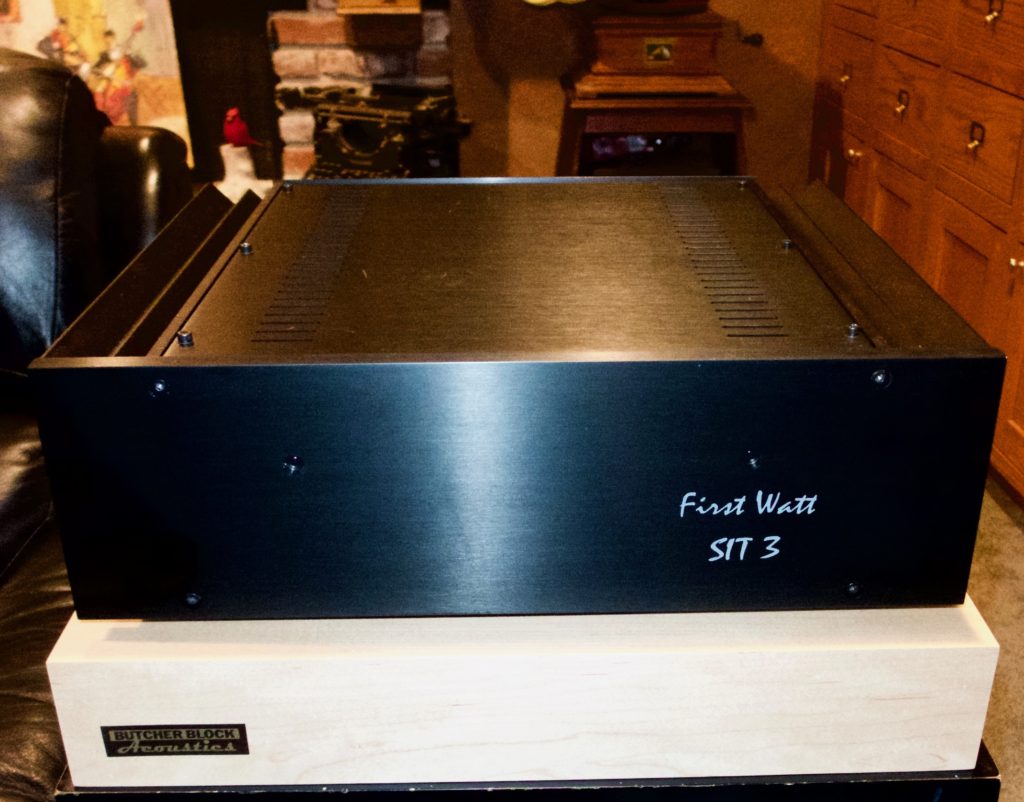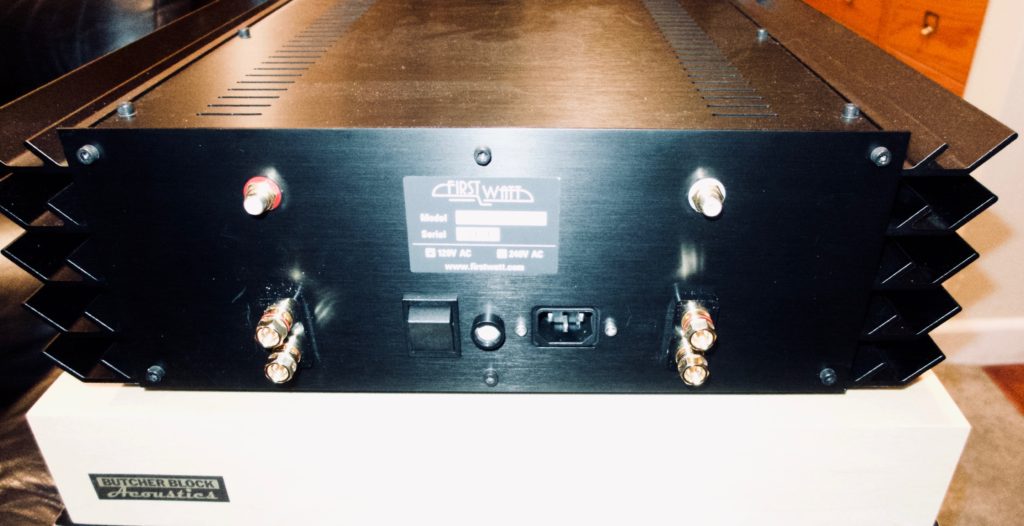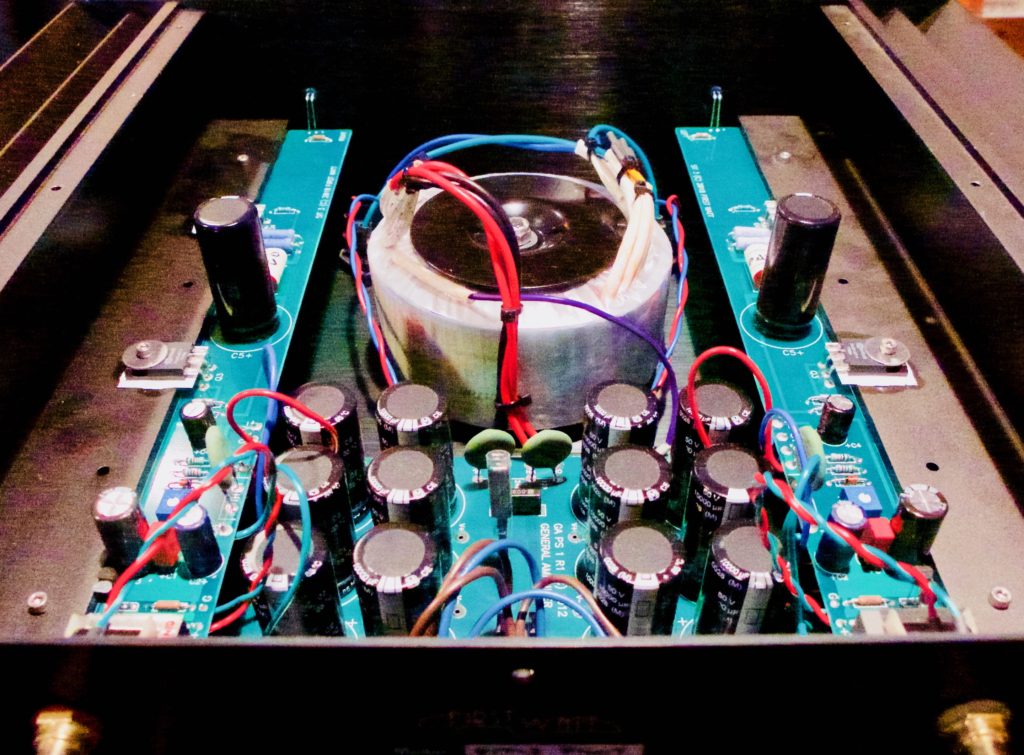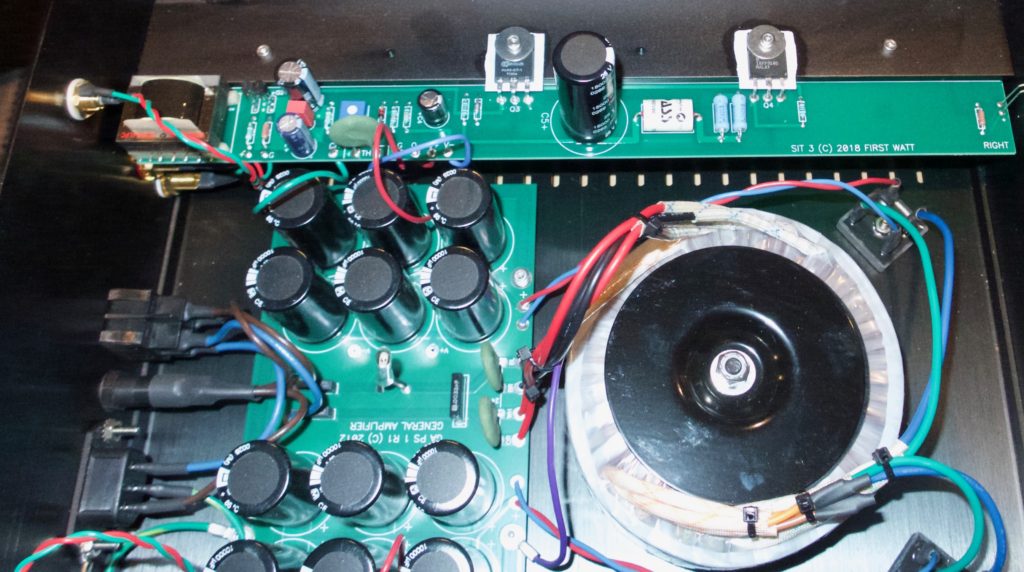
I don’t know if I have ever looked forward to reviewing an amp with such anticipation, and I’ve noticed that many of you also seem excited about the First Watt SIT-3. In my introduction to this review, I gave a brief technical description of the SIT-3 and a couple of comments on my first impressions of its sound. If you would like a really detailed technical description of the amp, Srajan Ebaen of 6Moons has a great one with pictures here. So, what about this amplifier in a plain black box that only puts out 18 watts into 8 Ohms and 30 watts into 4 Ohms causes such excitement?
Well, first of all, if you’ve been an audiophile as long as I have, you know Nelson Pass is a legend. I remember drooling over the Threshold amps when I was in my early twenties. Then, there’s the fact that First Watt is not like other amplifier companies. It was created by Nelson Pass pretty much for the fun of it. On his website, Nelson writes, “Dick Olsher famously remarked that “The first watt is the most important watt.” This sentiment has also been expressed by others as “Who cares what an amplifier sounds like at 500 watts if it sounds like crap at one watt?” With this in mind, I created First Watt in 1998 as a “kitchen-table” effort, exploring unusual low power amplifiers with an emphasis on sound quality.” Later on, Nelson says, “There is no such thing as a perfect amplifier. All audiophiles and their associated equipment have specific needs, but in each case, there is such a thing as a best amplifier — the one that makes you happy.”

In many ways, every First Watt amp is the expression of what is possible from a low power amp designed by a true artist who has proven his ability to create state-of-the-art amplifiers that can give you the ultimate musical and sonic experience. With this amp, there is the added excitement that Nelson is using the rare and seldom used SIT transistor. SIT is short for static induction transistor (i.e. a VFET), which is what the First Watt SIT-3 uses in its power stage. The SIT is a custom part that Nelson Pass commissioned from the now-defunct SemiSouth Company, and he says it has the character of a tube triode.
The SIT-3 is the 3rd and last of Nelson’s First Watt SIT amplifier designs. It differs from the SIT-1 and SIT-2 in that the SIT-3 is operated in common drain mode rather than common source modes like the SIT-1 and SIT-2. Common source mode provides both voltage and current gain for the First Watt SIT-1 and SIT-2 amplifiers, but the common drain mode in the SIT-3 provides only current gain, so Nelson utilizes an autoformer in the SIT-3 to boost voltage by 11dB.
Nelson says, “The SIT-3 has more power, more damping factor and less distortion than the previous SIT designs. It retains their desired second harmonic character with even fewer higher order harmonic components … The SIT-3 has an organic quality that breathes more depth and life into the music … This is one of those all-night, year-after-year pieces.”
So, now there is a chance for those of us who missed out on the SIT-1 and SIT-2 to own one of these rarities. If you want more technical information along with lots of graphs to compare the SIT to Pentodes, Mosfets, and Triode 300Bs, it’s all available in the First Watt SIT-1 owner’s manual, which you can download from their website.

Set Up and Break In
My system when I received the SIT-3 consisted of a DS Audio Master 1 Optical Phono Cartridge and Master 1 Preamp/Equalizer mounted in an AMG 12JT Turbo Tonearm on an AMG V12 Turntable. At the time, I was using the LTA MZ2 amplifier to drive my Teresonic Ingenium XR with DX4 Silver Speakers. All cables were either Audience Au24SX or Duelund tinned copper with baked cotton depending on amplification. The power cords were Audience Au24s plugged into an HB Cable Design’s Marble Power Distributor. So, I just replaced the LTA with the First Watt SIT-3.
The sound of the First Watt SIT-3 was all over the place during break in. Right out of the box, it was bright and steely sounding, then forward and a bit harsh. Finally, after about 300 hours, it sounded glorious.
Listening
When I sat down to listen to the SIT-3 there was one more thing that I simply couldn’t believe. I was listening to an amplifier that was designed by and hand-built by Nelson Pass himself! They won’t all be built by Nelson, but the first few were, and I was a little awe-struck by that. So, I’ve gone on long enough. It’s time to talk about how it sounds.
As I listened to the beautiful music coming from my system with the SIT-3, I started to realize that listening to this amp was going to be a comparison to four of my favorite amps; the WAVAC EC300B, Pass Labs XA30.8, Pass Labs XA25, and the First Watt SIT-1 monoblocks.
Nelson says the SIT-3 has a little more organic quality that breathes more depth and life into the music. I can attest that it surely is an amp that breathes life into music. It has a rich, dimensional sound that allowed me to hear real detail, but it sounded very natural and alive. Like the WAVAC EC 300B and First Watt SIT-1 monoblocks, the SIT-3 is best described by words like delicious, beautiful and beguiling. On the other hand, the Pass Labs XA30.8 is about power, control and musical flow. The XA25 is about warmth and big rich tones but still with great detail. They all produce a good soundstage, but the SIT-3 is the champion in that area. Like each of these amps, the SIT-3 sounds unbelievable good both musicality and sonically. I should also mention that a first-class power cord makes a huge difference in its performance.

Both the SIT-3 and the XA30.8 enabled me to hear the textures, colors, tones and harmonics of music more realistically than any of the other amps. The difference is that the SIT-3 emphasized all of these just a touch more, whether or not this makes it better than the XA30.8 will depend on your speakers. I prefer the XA30.8 on my Teresonics. I happened to have both the Legacy Audio Calibre and the NEAT Acoustic IOTA Alpha speakers in for review, and I preferred the SIT-3 with them.
The sound, its timbre realism with individual instruments and voices, is just so satisfying when listening with the SIT-3. It allows my system to play music with such an enjoyable life-like flow. It has great PRaT and great fullness at the same time. This is something I have never heard an amplifier achieve to this extent. I can’t believe I’m saying all this about a transistor amp. Remember Nelson’s quote above, “There is no such thing as a perfect amplifier. All audiophiles and their associated equipment have specific needs, but in each case, there is such a thing as a best amplifier — the one that makes you happy.” This is especially true when comparing the amps I’m writing about here, although we could take the WAVAC EC300B out of the discussion as it costs $30,000, which is four times more than the XA30.8. We can also take the SIT-1 monoblocks out of the discussion as they are sold out, and there won’t be any more.

So that leaves us with the XA30.8, the XA25, and the First Watt SIT-3. If we arbitrarily say that the XA30.8 is the neutral amp of these three, then we can borrow terminology from Harry Pearson and say that the XA25 is the yin side, tending toward dark, and the SIT-3 is on the yang side, more lit up and obvious. When I say more lit up, I don’t mean bright, crisp or detailed. I mean it places a light on the silky, rich midrange that makes it more obvious than the other two amps. The XA30.8 is fundamentally different from the XA25 and especially the SIT-3 in how it builds the sound on a foundation of bass, mid-bass, and power. At the same time, it has an equally wonderful midrange. Both the XA25 and especially the SIT-3 build the sound from the midrange out. It’s like the midrange is the main attraction, and the bass and treble are there to complete the sound.
The soundstage of the SIT-3 is pretty special because it is very wide, very coherent and reveals space in a spectacular way. Compared to the two Pass Labs amps, there was a slight emphasis of soundstage width over depth, but this emphasis was not enough to notice except on direct comparison. Instruments and voices were placed beautifully in their own space while still sounding like they were part of the whole performance.
Let’s Listen to Some Music
I still have the OPPO UD205 hanging around so I decided to listen to one of my favorite performances that, the SACD, King of the Cellist, Starker plays Kodaly. This is one of the most beautiful recordings of a cello that I have ever heard. It is also insightful to listen to the cuts that are the cello and the violin. With the SIT-3 this performance was emotional and involving. The cello had rich, big tone and beauty. The leading edge of both the cello and the violin was quick with a great sense of breath and space around and within it.
The cello was conveyed with beautiful richness and life without a hint of bass hangover or even the hint of excessive midbass bloom. The violin sounded very sweet and extended easily into its upper registries. It did seem very intense, and sometimes even aggressive, as it should on this piece. In fact, the pace and timing were exceptional. The emotions you experience as the bow is slowly pulled across the strings are so moving. I could hear the layers and textures of the tones of the strings as the bow passed over them.
Then I switched back to vinyl to listen to the 45 rpm Analog Production reissue of Verve’s Ella and Louis. On cut 2, “Isn’t This a Lovely Day,” I could hear the beauty and lushness of Ella’s voice and the gravely sound of Louis’ voice. The voices were very prominent, and the horn was brassy and had good bite The overall listening experience was so involving that I listened to the entire four sides.
Elvis is Back has Elvis’ version of “Fever” on it. I’ve said in the past that this cut will tell you if a system is all about slam and tightness or if it’s about emotion, music, and feeling what the musicians and singer are trying to convey. More than any other amp I have used the SIT-3 made it about both. It had more slam and was tighter in the bass than with either of the Pass amps, which in all honesty I was shocked that it was better the XA30.8 in that area. Within the sense of a musical performance, the SIT-3 enabled me to hear the decay, the reverb and how close Elvis was to the mic. “Fever” really sounded great on my system with the SIT-3!
I also listened to the MA Recordings J. S. Bach Goldberg Variations LP 20th Anniversary Edition performed by Ito Ema. I picked up this LP about a year ago, and I have spent a lot of time listening to it. I can tell you I have never heard it sound as beautiful as it did with the SIT-3. Now the actual live performance may have been a little more beautiful, but I’ll never know.
Conclusion
The SIT-3 amplifier is the real thing, and it brings you a taste of a real performance. If you have never heard a well-executed SIT or VFET amplifier, you really have no idea how good a transistor amp can sound. Yes, Sony and Yamaha made some transistor amps that sounded very special, and they are very hard to find used. These amps, however, didn’t have the bass impact of the three SIT amps designed by Nelson Pass.
The SIT-3 is also one of the most seductive amplifiers I have ever heard, and it is equally excellent at the frequency extremes. All of the First Watt amps are special, but the SIT-3 is very special indeed, and this may be your last chance to own a SIT/VFet amp.
Specifications:
- Maximum output: 18 watts @ 8 ohms, 30 watts @ 4 ohms
- Input Impedance: 200K ohms
- Gain: 11 dB non-inverting phase
- Damping Factor: 30
- Frequency Response: 10 – 50 kHz – 3dB
- Price: $4,000

May i ask what power cord did you end up with on the SIT 3 ?
Ken, thanks for reading The Audio Beatnik. I tried it with the cable it came with, the Clarus Aqua, the WyWires Platinum HC, and the Audience Au24SE. Both the Platinum and the Au24SE were very good but in the end, I used the Audience AU24SE for the review.
Thanks for the reply Jack…
I have one of these amps and your review is “spot on”.
How it sounds is quite hard to put into words, Because you really need to experience it..
However, I think this quote from your review comes very close.
“The sound, its timbre realism with individual instruments and voices, is just so satisfying when listening with the SIT-3. It allows my system to play music with such an enjoyable life-like flow. It has great PRaT and great fullness at the same time. This is something I have never heard an amplifier achieve to this extent.”
“Satisfying” is not a term you often see used in an audio review , yet I think it perfectly describes the SIT-3 sound. There is a calmness about the sound and a disarming nature in that you are not alerted to any particular characteristic of sound. I would also add “captivating”…. Once you are listening to the amp for a few minutes, you simply “fall into” listening to the music and its artistry. You forget the equipment and sit and listen to the MUSIC , not the system..
It all feels right…
Nicely done Jack..
Keep up the good work..
Ken … aka The Dog
Hi Ken,
On the list for delivery mid to late Sept. Do you find any break in period, and if so what? What are you using for Preamp and speakers?
Rob
Yes, it did require breaking. I left if playing at very low volume for about 200 hours while we were out of town for T.H.E Show. Details on the equipment used in the review system are in the post.I actually had the opportunity to review it with several preamps and speakers.
Could you give us a bit more detail on SIT-1 vs SIT-3? Thanks.
It has been so long between having the SIT-1 monoblocks that I really can’t add any more.
Thanks for reading The Audio Beatnik
Jack
Jack – Iknow it’s not a fair fight, but how does the SIT-3 compare to your WAVAC 300Bs?
James, I am so sorry I missed your comment. The SIT-1s sound much more like the WAVAC E C300B amp. The SIT-3 has better and deeper bass and a more extended top end. It had slightly better tempo. The EC300B is has a little more magical midrange.
Thank for reading our site.
Jack
How does this amp compare to the LTA Ultra-linear? Right now i have Tekton Double Impact speakers driven by a LM 518ia, i have owned the 518ia for the last four years and it sounds great i just have a desire for something different but be the equal of the 518ia or better. Thanks, Dave.